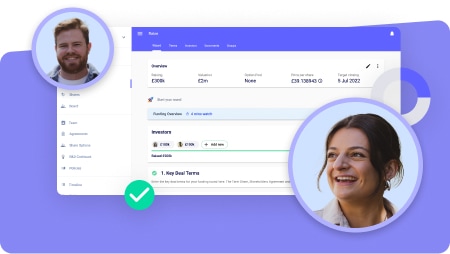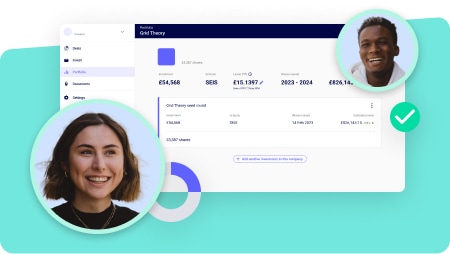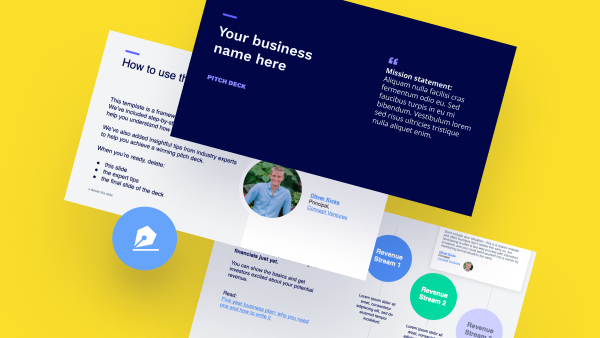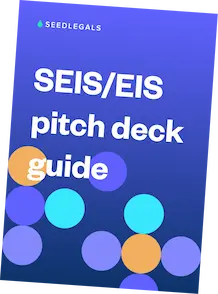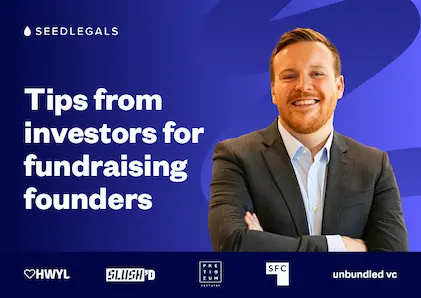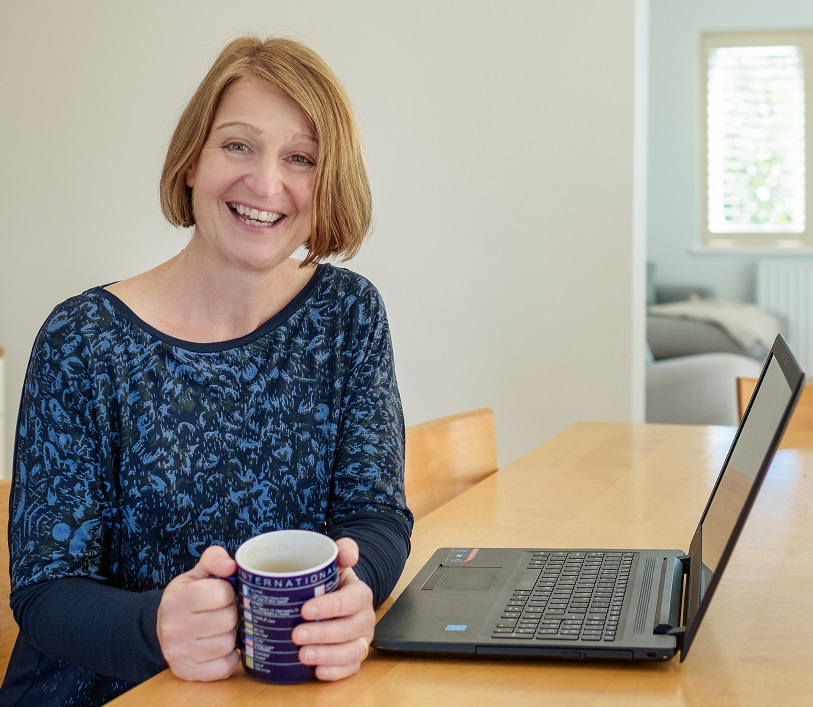Read transcript
Hatty: Welcome to today’s SeedLegals and Focused for Business co-hosted webinar. We’re here to talk about how to find a lead investor. You have two of us this morning, myself and Adam. Adam, do you want to introduce yourself? We should also mention that Adam is so committed to presenting this content today that he’s joining us from his holiday in Florence. Adam, how’s Florence and how are you?
Adam Thank you, Hatty. Florence is amazing. There’s been a lot of walking around so it’s actually a bit of a relief to take a break and sit down for an hour. I’m Adam, a funding round expert at SeedLegals. I work closely with founders to help them set their funding terms, understand what those terms mean and navigate their impact. That’s my spiel – Hatty, over to you to introduce yourself.
Hatty: Thank you. For those who don’t know me I’m Hatty Fawcett, the founder of Focused for Business. I originally started out in marketing but later reconnected with my entrepreneurial side and have now worked in three startups. The first startup I joined grew from zero to £3 million turnover in two years; a rollercoaster ride I enjoyed so much that I did it all over again with my own business. That business also grew quickly which meant I needed to raise investment. Having never done that before I made many of the mistakes founders often make. Ultimately I raised three rounds of investment.
After exiting that business, I managed investments made by Kelly Hoppen when she was a dragon on Dragon’s Den. That experience gave me insight into funding from an investor’s perspective: what angel investors look for when backing a business. These days I run Focused for Business, a training and coaching practice designed to make it faster and fairer for founders to raise their first or second equity funding round. I say fairer because there are many barriers. The statistics for female founders raising investment are atrocious – less than 3% of funding goes to female founders. It’s even harder for ethnically diverse founders and those outside of London. These are unacceptable reasons for businesses to struggle with funding and my mission is to level the playing field.
Adam and I have a lot of content to cover today so let’s get started. Our plan is to leave time at the end for questions so please pop them in the chat as they come to you and we’ll address them later.
So the first thing I want to talk about: raising investment is really a confidence game. It is very risky backing startups. Nine out of ten startups fail in the first two years of trading. That’s not my data, that’s data from the Office for National Statistics.
Investors know it’s risky, so they’re looking for ways to minimise their risk. They’re looking for signals, things that give them confidence that your business, or the business they are about to back, is more likely to succeed than other businesses that might be looking for cash at the same time. In a way, you’re in competition with other businesses, not just businesses in your sector but also other businesses raising investment at the same time as you. The game is really to see if you can evidence that you’ve built a business with a product or service that customers want, that you can sell that product or service, and therefore there is a business ready and waiting to grow so the risk for investors is minimised.
One of the key signals that helps demonstrate you’ve reduced risk is if you can attract your first investor, particularly a lead investor. This sends a signal to other investors that someone has looked at your business and sees something worth backing. Getting your first lead investor encourages others to consider the investment opportunity too.
A lead investor is someone who commits to your funding round early, maybe the first or second investor. But they are more than just an early backer. Who they are is also important. They are usually independent; not someone you know, not a team member, not friends or family backing you just because it’s you. They are independent people assessing the business opportunity and recognising its potential. Often, they understand your sector, your business model, or your technology, and by backing you, they send a signal that what you’re doing is interesting.
What’s really important about a lead investor is they commit to the round early. By commit, I mean they go through a term sheet with you and probably start negotiating with you on valuation. They dig into the detail. This isn’t a superficial “I’ve seen your pitch deck, I like it, I’ll back you.” No, they go further. They conduct due diligence, examine your term sheet, and say, “I agree with these terms, I can invest under these terms,” and maybe negotiate valuation before signing the term sheet. Adam will talk more about the importance of this term sheet in a moment.
A lead investor typically commits a chunk of your funding round, but they don’t have to be the largest investor. Sometimes, their reputation, knowledge of your sector, and credibility matter more than the amount of money they’re committing. What matters is who they are — do they understand your sector? Are they a regular professional investor? Do they know their stuff? Their backing sends a signal to others.
Beyond the cash, they may bring strategic value. If they have run businesses before, they can help you grow efficiently. If they understand your sector, they can provide strategic advice. If they are well-connected, they can introduce other investors to the round or open doors to key clients and partnerships that help your business grow faster. A really good lead investor brings a combination of these things, and that’s what you should look for.
Nobody likes to miss out. A lead investor signals to other investors that someone knowledgeable is interested, so they should get involved. You want to use a lead investor to create a sense of FOMO, that fear of missing out. When you get a lead investor, start talking to others, saying, “We have so-and-so committed, and this is why they say they’re joining the round.” Use the investor’s words rather than your own. This creates excitement and urgency. You can say, “We’re now at term sheet with our lead investor and aiming to close the round by the end of the month. If you want to be part of this round, now is the time to get in.” You’re creating urgency, a reason to act now, and standing out. Not all startups looking for cash at the same time will have a lead investor, especially one with credibility in your industry. Use that lead investor to open doors to others—don’t let anyone miss out.
Now some people seem to think it’s quite hard to find investors. I actually don’t think it’s hard to find investors. I run a funding accelerator programme where we give people going through that program a list of investors that back businesses like theirs so they can reach out to them. For me, what’s harder is what you say to investors to get them on the hook. So what I want to look at now is two things: where are you going to find investors and what are you going to say to them when you’ve got them.
Lots of leads for you here as to where you could go and find investors. We’ve got some free resources on the left-hand side and some paid-for ones, but I understand startups are on tight budgets, so I’ve tried to keep my recommendations cost-effective. Let’s tackle the free resources first. A really simple place to start is Companies House. On the Companies House website, you can type in any company and look at their filings. Often, you can work out who has invested in a business, and if it’s a business with a similar model or sector to yours, that investor might be interested in backing you.
Another free resource is the Barclays Demo Directory, which connects startups with investors. Both parties register on the platform and make connections. There are other platforms too, but I’m not going to list them all here. I’m also quite interested in Ship Shape, which is a free search engine for finding investors. I’ll stick a link to it in the chat box. This is particularly useful because it not only helps you find funds backing businesses like yours, but it also identifies the individuals within those funds who review businesses in your sector and at your stage.
Ship Shape is about to launch new tech that lets you see how much money is left in a fund. You’ll see when they raised, how much they raised, and how much has been deployed, helping you decide whether to approach that fund. If the fund has invested all its money, you can avoid wasting your time.
On the more specialist resource side, there are databases like PitchBook, Beauhurst, and TechCrunch that pull information from Companies House and elsewhere to help you search for investors. We use another system called Mark to Market in our funding accelerator program. These databases often come with high subscription fees, so they may not be within budget for every startup. However, you might know someone who has access and can do a quick search for you – perhaps even your SeedLegals contact.
A more cost-effective way for early-stage businesses is Scribe. Scribe scrapes data from Companies House, aggregates it into a database, and augments it with additional investor contact details. You can search by sector to find the right investor and access their contact details. Scribe also runs outreach campaigns via email and LinkedIn to help startups connect with investors. We partner with Scribe, and they offer £20 off the monthly subscription if you use the code ‘Focused20’.
So, you’ve found investors. You know you need a lead investor. You’ve reached out to investors. Now, how do you get them on the hook? As a marketeer by training, I use a funnel approach. You’ll have lots of leads going into the top of the funnel, and you need to quickly sift through them to find the right investors for you. You don’t want to waste your time speaking to the wrong people. You’ve got a business to run alongside your funding campaign, so let’s get focused.
I like to use the AIDA framework – Attention, Interest, Desire, and Action. Think about how someone progresses through these stages to assess whether an investment opportunity is right for them. First, you need to get their attention. The best way is to align with their preferences. Many investors focus on particular sectors like HealthTech, EdTech, or anything using AI. Some invest in early-stage businesses, while others, like VCs, wait until you have recurring revenue. Target the right investors for your stage and sector. Don’t waste time talking to the wrong people.
Once you have their attention, you need to get them interested. This means providing more information about your business. Talk about the problem you’re solving, how you’re solving it, what’s new, what’s innovative, and what’s different from others. Show the value you offer customers.
To move them from interest to desire, investors need to dig into the detail. They’ll want to know about your team – are these the right people to build and scale this business? They’ll look at your financial forecast to see if you have a clear growth plan. When an investor is seriously interested, they’ll want to see a valuation and a term sheet – Adam will talk about term sheets shortly.
In guiding investors through these four stages- Awareness, Interest, Desire, and Action – there are five key documents you need. I call them the Big Five. The first two are for generating awareness and interest. You need to quickly show an investor what your business is, where you’ve got to in your growth journey, and help them decide if it’s something they want to pursue.
First, you need an elevator pitch- a 60 to 90-second spoken summary of your business, covering what it does, where you’ve got to, and what you’re looking for. Second, you need an introductory email, a short and punchy email that others can use to introduce you. Getting an introduction is always better than cold outreach. People prefer to meet founders who have been recommended by someone they trust.
Sometimes you need more than an elevator pitch or a short email. That’s where a one-pager or teaser deck comes in – four or five slides that tell your story. But do not send your full pitch deck to get a meeting. Your goal is to meet the investor and present your pitch. If you send your deck in advance, they may feel they don’t need to meet you. A presented pitch should be delivered in person or via video call, with minimal text on slides to ensure your verbal delivery complements the visuals.
Once you have an investor on the hook, they will want more details. You’ll need a business plan, a detailed pitch deck, and a financial forecast covering three to five years. Be prepared before you start conversations with investors – nothing is more embarrassing than an investor asking for a forecast or valuation justification and you scrambling to put one together. That undermines your credibility. Serious investors see multiple deals, and if they have to wait for information, they may move on to another opportunity.
So, be prepared. Have your Big Five ready before you start conversations. Now, let’s move on to getting investors over the line. Adam, this is where you come in. This is where the term sheet really comes into play.
Adam: Yeah, so thank you very much, Hatty. Principally, a term sheet is about breaking down in simple, digestible words and structure what the key terms of the deal are going to be. It’s a simplified version of what will be in the shareholders’ agreement once the round closes. It’s a non-legally binding document and is typically only two to three pages long. It’s where negotiations begin.
Sometimes, the lead investor will come to you with their term sheet, outlining the terms they expect to see in the round. But just as often, the company approaches investors with their own term sheet, saying, “These are the terms we’re happy with. What would you change?” From there, you can begin discussions and refine the agreement.
Term sheets vary depending on how you’re raising funds. The most important distinction is with convertibles – typically an Advance Subscription Agreement (ASA), or if you’re a SeedLegals customer, a SeedFAST. This allows the company to secure capital sooner. Investors put the money in upfront, and their investment converts into equity when the funding round closes. Investors using ASAs rely on future lead investors to set the terms based on due diligence conducted within the round. However, in our experience at SeedLegals, investors investing via an ASA don’t necessarily rely solely on the assumption that a lead investor will set terms – they are quite flexible and willing to have it convert outside of a round if needed.
Within the funding round, terms are negotiated in a balance between economics and control. If you push harder on one side, the other side often requires some concessions. On the economic side, the valuation of the company, the price per share, the share class, and rights such as anti-dilution or liquidation preference all come into play. On the control side, drag-along and tag-along rights, vesting schedules, investor consents, and board composition are key elements. If you negotiate a higher valuation, an investor might push for more control, such as a board seat or additional investor consents.
Organisation is key when preparing for investment. Early-stage companies should have three main things in place: 1) A clear founding team structure, ideally with a founders’ agreement and understanding of vesting schedules. 2) Proper Companies House filings, ensuring everything is well-documented, as investors will check these public records. 3) Advance assurance for SEIS/EIS, as many institutional investors and large angels (ie the people you’re targeting as your lead investor) will require it as part of due diligence. SEIS/EIS applications take 15 to 40 working days to process, so getting them done early avoids delays in investor conversations.
If you don’t have a lead investor, that’s okay. As long as all investors agree on the term sheet, you can still proceed. However, having a lead investor helps create FOMO (fear of missing out) and makes it easier to close the round. Supply and demand matter – if multiple investors want in, you have more leverage in setting favorable terms. You can also use ASAs to bring in part of the round earlier, reducing pressure and avoiding a “raise or die” scenario where founders feel forced to accept unfavorable terms.
Hatty: To illustrate how this works, let’s look at a case study. Drew Doodmar, founder of Hip & Henry, makes sustainable, recyclable children’s shoes. She joined our funding accelerator program at a critical time – she had a great product and customer demand but lacked the cash for production. Investors prefer businesses with sales traction, so she faced a challenge: she needed investment to produce stock, but she needed stock to generate sales traction for investors.
Drew prepared all her investment documents – forecast, pitch deck, valuation, term sheet– and underwent an independent investability assessment. She received a strong rating and shared her report with investors, which quickly attracted a lead investor. That investor committed £50,000 via an ASA, providing the cash for production while she continued raising additional funds. She ultimately exceeded her initial target of £150,000, raising £200,000. This extra funding gave her more runway to achieve her growth goals.
Before we move on to questions, here are some resources. If you’re considering raising investment, make sure you have traction first. It’s a tough funding market, and just having SEIS/EIS Advance Assurance and a great idea isn’t enough. Investors want to see progress. We have a 20-question scorecard that helps founders assess their readiness through an investor’s eyes. The link is in the chat.
If you’re confident you’re ready to raise, I run a weekly funding strategy workshop with insights on what it takes to raise in the current climate. We also provide valuation benchmarking tools and progress assessment tools. If you’re interested, come along to the Funding Accelerator Workshop.
We’ll send around an email with the recording and additional resources. Now, let’s move on to your questions.
The first one I saw was from Beth. Beth talked about what should you do if an investor asks for your pitch deck before you’ve met them. There was some feedback in the chat about not sending it and pushing back, and I cannot agree with that more. Beth, please don’t send your pitch deck. A pitch deck should be presented, and you can say that in an email: “I’d love to take you through my pitch deck, but it does need us to meet.” Then, have your teaser that you can send instead. Send them a little more information so they can find out about what you’re doing, but push for a meeting: “Let’s get a date in the diary, and I’ll come and explain everything to you.” Use it as an opener to push back, send a teaser, and get the meeting.
Would you add anything to that, Adam? Anything from your experience, what you’ve seen working?
Adam: No, I would completely agree. Our CEO tends to refer to the pitch as being like a trailer for an action film. You want to use it to generate as much excitement as possible, and it’s really hard to do that just in a document itself. It requires the founder to be there. Also, if you’re in a pre-revenue company, the investor is investing in you as the person behind the company just as much as the company itself, and you’re going to be able to get that across much, much better in person. So, yeah, always trying to push for a meeting is best.
Hatty: Super. There was a question from Zara that’s probably one for you, Adam, about the term sheet. It was an interesting one. Zara was saying she didn’t realise the term sheet was not legally binding, which it’s not. And therefore, if you’ve got an investor on the hook but you get a better offer from someone else, can you ditch investor No. 1 and move over to No. 2? What’s the legal stance on that, Adam?
Adam: If all you’ve signed currently is the term sheet from one investor, then legally, it isn’t a problem to go with the better deal from another investor. But I’d say there’s possibly a more tactful way of handling it. You might have landed them as a lead investor, but you’re probably still looking to fill the round. So, instead of ditching them outright, you could have an open conversation: “Actually, we’ve got this investor who’s willing to match your investment, but they’re coming in at these terms. What’s your flexibility to still invest but move, at the very least, closer to these better terms?”
Hatty: I completely agree. There’s the legal stance, which you’ve rightly said, and there’s the relationship-building stance. Fundraising is about building relationships – not just for this round but for future rounds as well. If you upset someone today, you probably won’t get them back in the future. So tread gently. As Adam said, you can still have the conversation: “We’ve been offered better terms; would you consider matching?” But do it positively. Don’t just ditch someone and move on, because that could come back to bite you. Treat people kindly, and you’ll get what you want. Be mean, and you might just get the same treatment yourself.
Okay, I think the next question I spotted was from Kat about the UK equivalent of a SAFE. The SAFE is the American legal vehicle, but the ASA is our version, right?
Adam: Yeah, exactly. They function very similarly. The main difference in the UK is that it normally operates on a pre-money valuation rather than a post-money valuation. I won’t go too much into why that’s more beneficial because that could be a whole 30-minute webinar. But yeah, ASAs are really fantastic tools to take in capital quickly, and then they convert into equity within what’s called a qualifying funding round, which is where you say, ‘As soon as the company has raised X amount, it will convert into shares at the valuation that X amount was raised at.’ Or it converts at a long stop date, which for SEIS must be six months. Good tools.
Hatty: The only thing I’d say about ASAs is to tread a little cautiously. Not all angel investors like ASAs because the valuation isn’t set and a term sheet isn’t agreed upon at the point of signing. Some investors feel that leaves them exposed to valuation and term sheet changes when the ASA eventually converts. They’re a super useful tool, so I’m not saying ditch them, but go in with your eyes open. Not all investors are going to like them, so be ready to be flexible. If an investor is the right one for your business but doesn’t want to do an ASA, don’t ditch them just because they won’t do the deal in the way you prefer. Be ready to talk.
Zara had another question about board makeup – who decides who should be on the board? Is it the investor, or is it a joint decision with the founder?
My opinion is that it should absolutely be a joint decision. I’d always lean towards having an uneven number of board members – three, five, or seven. You want someone representing the founders (often the founder themselves), someone representing the investors (often the lead investor), and someone independent who represents the business and customers. Just sometimes, founders and investors have different agendas, and having an independent company representative can be really helpful. As your business grows and regulatory complexity increases, you may want to expand your board. But early on, don’t overcomplicate it.
I also saw a question from Mathias about getting investor-ready for SEIS. This is that classic chicken-and-egg situation – do you need an investor before applying for SEIS?
Adam: Yeah, this rule was introduced about three years ago. SEIS doesn’t want speculative applications; they want to see a realistic chance that the company will raise the money it applies for. Ideally, they want to see some traction, so even if you just put down interested parties, that helps. There’s no obligation for those investors to follow through, but it gives HMRC confidence that the money will be raised. If you don’t have an investor to list, you can submit a side letter explaining your fundraising strategy – what events you’ll attend, how you’ll network, and any leads you already have.
Hatty: That’s really sound advice. I saw a question from Chem about setting up an SPV (Special Purpose Vehicle) for a seed-stage startup.
Adam: It depends on how you’re fundraising. The point of SPVs or nominee structures is to keep the cap table clean if you have lots of small-ticket investors. It also makes it easier to get signatures in the future. Generally, if an investor is putting in £25K or more, they should be on the cap table directly. If you have 25 smaller investors, an SPV could make sense. But if you only have five or ten, it may not be worth the setup cost.
Hatty: That’s solid advice. There are also options to tidy up cap tables later as you grow.
Beth asked about having advisors on board pre-investment – does it help?
Absolutely. Early-stage, you probably don’t have the budget for a full team, but you still need access to skills. Investors will look at your team and assess any gaps, so if you’ve surrounded yourself with advisors, mentors, or fractional experts, that’s a savvy move. It also takes pressure off you as a founder. Early on, this can be informal, but if you plan to include advisors in your pitch deck, make sure they know and agree with how you’re presenting their role. Consistency is key.
We’re almost out of time, but I saw a question from JP Dumas about valuation. We didn’t talk about SeedLegals’ valuation service, but I mentioned an independent investability assessment, which is slightly different. It evaluates your pitch deck, financial forecast, and other key aspects of the business, providing an independent report on investment readiness.
We’ll wrap up there. Thank you, SeedLegals, for hosting, and Adam, for joining us even while on holiday. Founders, enjoy your weekend—take time to recharge. Have a great one!
If you’re raising a funding round, you’ve probably heard that you need a lead investor – but no one really tells you how to find one or what they actually do.
In the recorded webinar below, Hatty Fawcett, founder of Focused for Business, and Adam Phillips, CX Associate – Funding at SeedLegals, share the advice they give founders every day. Between them, they’ve helped hundreds of startups raise successfully and they’ve seen firsthand the difference a good lead investor can make.
Watch to learn:
- How to spot the right lead investor
- What to say to get them interested
- How to use that early commitment to bring the rest of your round together
Key takeaways
Why lead investors are important
- If you can attract your first investor, particularly a lead investor, it sends a signal to other investors that someone has looked at your business and sees something worth backing
- It reduces the perceived risk for other investors by showing that someone has done due diligence
- They can provide strategic guidance, industry expertise, and valuable introductions to other investors or key business contacts
Hatty FawcettWhen you get a lead investor, start talking to others, saying, “We have so-and-so committed, and this is why they say they’re joining the round.” Use the investor’s words rather than your own. This creates excitement and urgency. You can say, “We’re now at term sheet with our lead investor and aiming to close the round by the end of the month. If you want to be part of this round, now is the time to get in.”
Founder,
How to find and engage investors
- Identify investors through free resources like Companies House, Shipshape and Barclays Demo Directory
- Use paid databases like Pitchbook and Beauhurst if budget allows or leverage contacts who have access
- Leverage networking and warm introductions to improve investor engagement
- Send a teaser document instead of a full pitch deck to secure a meeting with investors
- Position your pitch as a conversation starter, not a standalone document
- Prepare key documents (elevator pitch, intro email, one-pager, teaser deck, full pitch deck) before engaging investors to avoid losing interest due to delays.
Term sheet 101: How to negotiate with and manage investors
- Negotiate valuation and terms before accepting a lead investor’s offer to secure the best deal
- Balance valuation and investor control; higher valuations often mean giving investors more control
- Ensure board composition balances founder, investor, and independent interests
- Use SEIS/EIS Advance Assurance to attract UK investors, but be prepared to show investor interest
Adam PhillipsSupply and demand matter – if multiple investors want in, you have more leverage in setting favorable terms. You can also use ASAs (or SeedFASTs, the SeedLegals version) to bring in part of the round earlier, reducing pressure and avoiding a ‘raise or die’ scenario where founders feel forced to accept unfavorable terms.
CX Associate - Funding,
SeedLegals webinars and events
Join us at our next event
Expert panels, illuminating webinars, genuinely fun networking ... be the first to hear about all our upcoming events.

Get help with your funding legals
Raising investment is exciting, but the legal side can feel like a minefield. Whether you’re just getting started or already talking to investors, we’re here to help you keep things moving.
At SeedLegals, we’ve helped thousands of founders close funding rounds faster or secure one-off investment outside a round with SeedFASTs or Instant Investment.
Got questions about how it all works or just want to sanity-check your plan? Book a free call with one of our funding experts and let’s talk it through.
Get answers fast, for free


